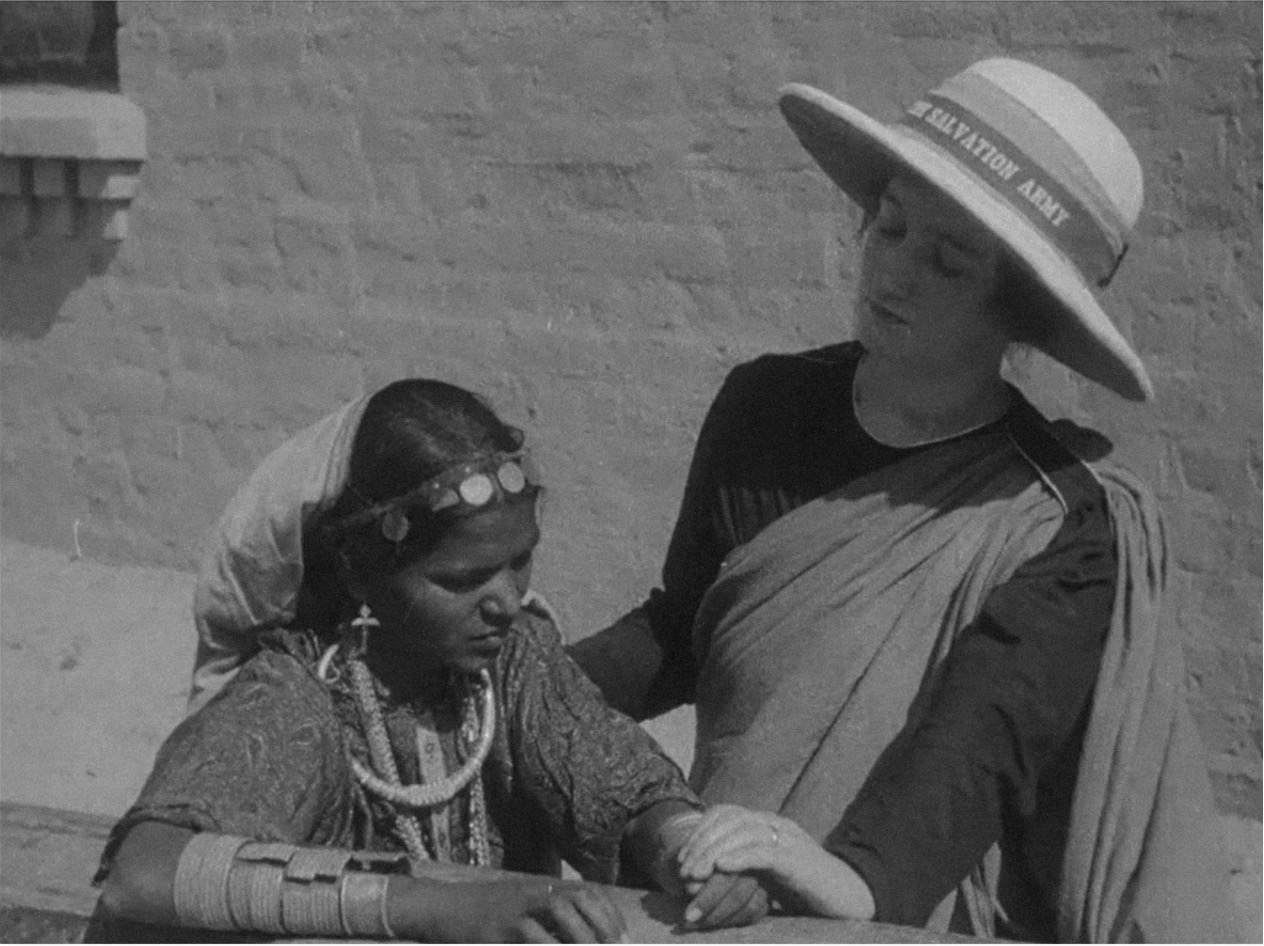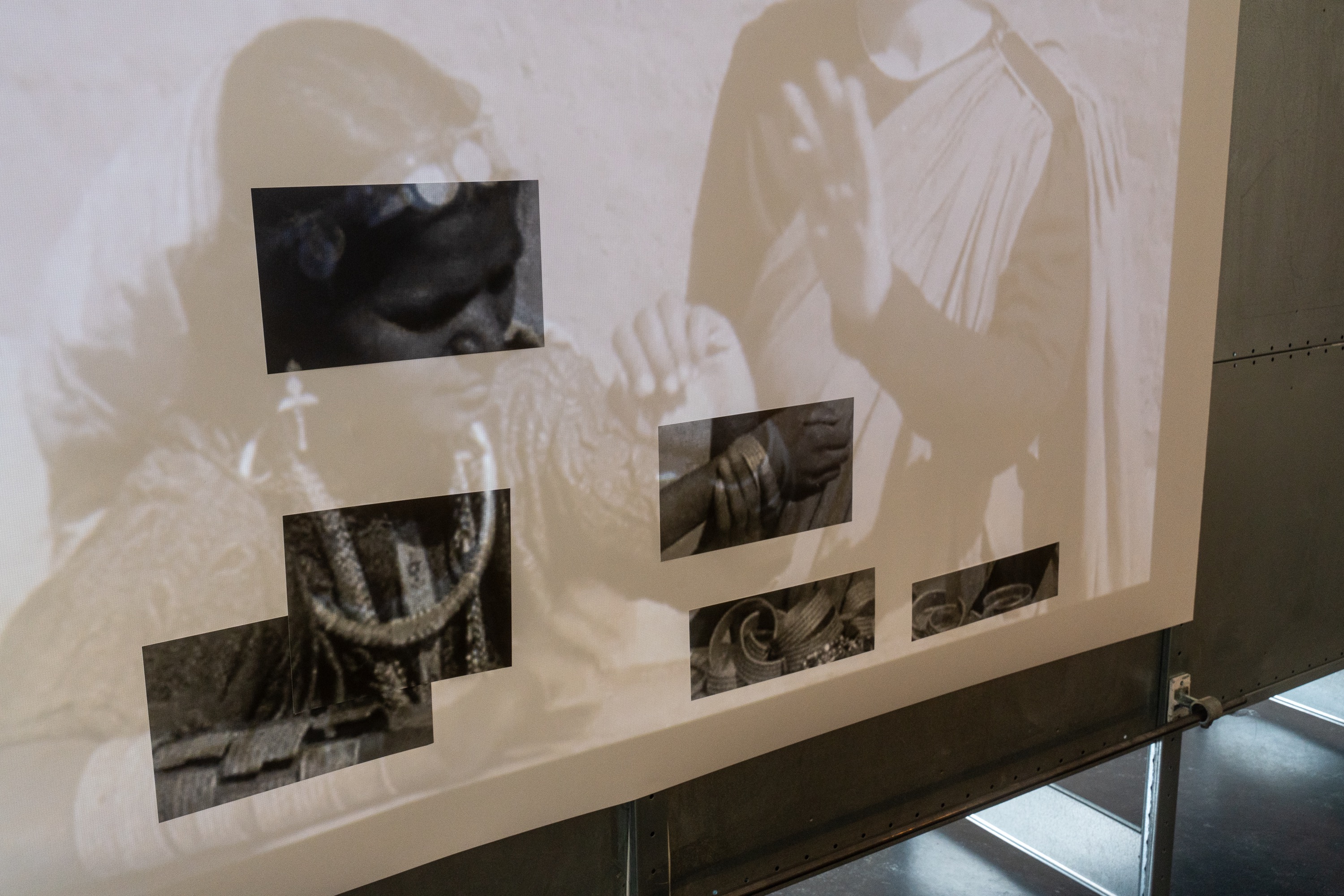The Apsara’s Seat
–
Ritvik Khushu
–
Ritvik Khushu
The Apsara’s Seat is a multimedia installation and performance that threads into relation beings, senses, and imaginations historically severed, disfigured, or veiled as a consequence of colonialism in South Asia. The project follows two fragments of moving image: an excerpt from a campaign film on the Salvation Army’s work in India, Burma, and Ceylon (1925), found in a colonial archive, and a performance by Sri Balasaraswati from Satyajit Ray’s documentary Bala (1971).
![A Salvation Army officer is seen coercing an Indian woman to give up her traditional jewelry. Stills from a campaign film, Salvation Army Work in India, Burma, and Ceylon, 1925.]()
The installation begins to open up the worlds contained within their frames and, subsequently, the worlds hidden, veiled, or dismembered. Jewellery labelled as being of ‘unknown origins’ in museum archives is cast in aluminium, and the same jewellery is imprinted in earth. Translations of Shakuntala by Sir William Jones are weaved into three iconic portraits painted by the father of Modern art in India, adorned with flower garlands and presented behind veils. The voices of Ravi Shankar, the footsteps of Bala, and other sounds resurface.
Through story, song, the visible, and the veiled, the project interweaves the many protagonists (and beings) of these stories to reveal (and heal) the imagination as an ecology.
![]()
![]()
Jewellery found in digital catalogues of ethnographic museums labelled “unknown origins”, are casted in Aluminium and in Earth.
Like entire lands with their cultures and autonomies, the imagination too is a territory and terrain subject to colonial conquest and plunder. How do you imagine the winds or the breath? The rains or the river, the ocean or mountain, Earth or the self? Imaginations produce experience. And experience is the domain usurped by the discipline we call design.
![The jewellery imprinted in Earth became a way of by-passing the firewall – that is the digital archive, it became a way to claim meaning and recall those objects severed from our communities.]()
My work thinks along with that of Rolando Vázquez, María Lugones, Arturo Escobar, and Ahmed Ansari to ask from what worlds of sensing, meaning, and relating do we do design? What worlds are made visible (or rendered invisible) in our practising of design? And what processes are the materialisation or immaterialisation of entire worlds subject to?
![Stills are placed on the screen to emphasize a moment in the film, to let the viewer linger in the exchange a little bit longer.]()
The re-membering of the apsara, devadasi, kali, or Earth in relation is an act of healing, of replenishing the imagination as an ecology partly laid to waste. The recalling of exiled or outcast figures becomes a means of questioning: how are we made to sense, through whose eyes are we made to see?
![]()

The installation begins to open up the worlds contained within their frames and, subsequently, the worlds hidden, veiled, or dismembered. Jewellery labelled as being of ‘unknown origins’ in museum archives is cast in aluminium, and the same jewellery is imprinted in earth. Translations of Shakuntala by Sir William Jones are weaved into three iconic portraits painted by the father of Modern art in India, adorned with flower garlands and presented behind veils. The voices of Ravi Shankar, the footsteps of Bala, and other sounds resurface.
Through story, song, the visible, and the veiled, the project interweaves the many protagonists (and beings) of these stories to reveal (and heal) the imagination as an ecology.


Jewellery found in digital catalogues of ethnographic museums labelled “unknown origins”, are casted in Aluminium and in Earth.
Like entire lands with their cultures and autonomies, the imagination too is a territory and terrain subject to colonial conquest and plunder. How do you imagine the winds or the breath? The rains or the river, the ocean or mountain, Earth or the self? Imaginations produce experience. And experience is the domain usurped by the discipline we call design.

My work thinks along with that of Rolando Vázquez, María Lugones, Arturo Escobar, and Ahmed Ansari to ask from what worlds of sensing, meaning, and relating do we do design? What worlds are made visible (or rendered invisible) in our practising of design? And what processes are the materialisation or immaterialisation of entire worlds subject to?

The re-membering of the apsara, devadasi, kali, or Earth in relation is an act of healing, of replenishing the imagination as an ecology partly laid to waste. The recalling of exiled or outcast figures becomes a means of questioning: how are we made to sense, through whose eyes are we made to see?
